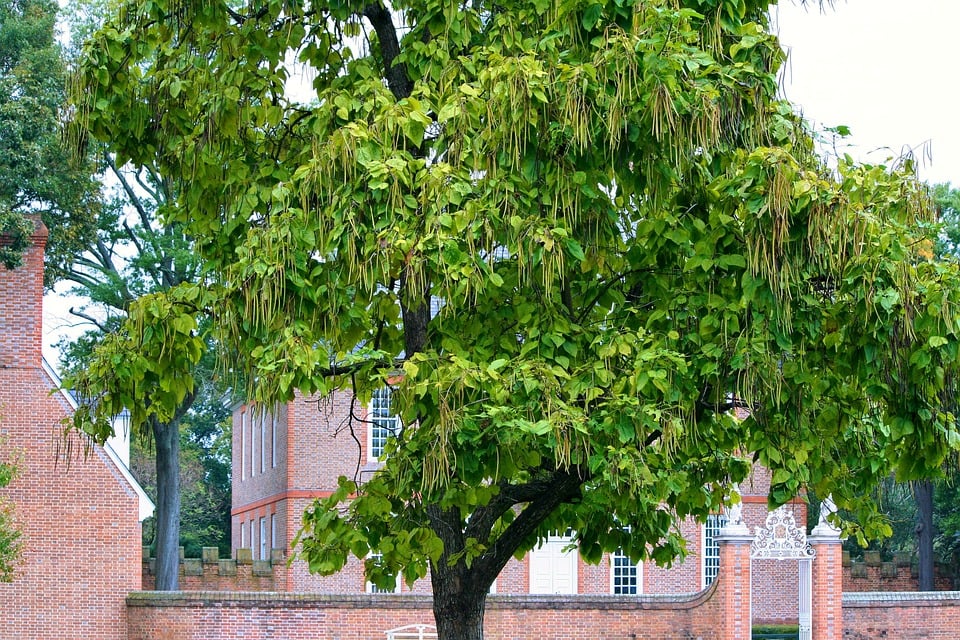Sorry folks, catfish don't grow on trees, but there is a tree that can help you catch more catfish: the catalpa tree (Catalpa spp.). You've seen them in people’s yards as you enter many small towns in the American south.
They stand out in a crowd of trees because of their unique lite green leaf color. Their large leaves provide excellent shade, and their flowers fill the canopy with showy white blooms. But that's not why catfish love them; the connection between catalpa trees and catfish is the catalpa worm.
Catalpa Trees 101
 Catalpas are found throughout the United States, but originated in the Appalachians and the American southeast. Catalpa trees actually have soft, light, rot resistant wood that is great for furniture, boats, cabinetry, and carving. Despite the catalpas' many utilitarian uses, they are most renowned for the parasite that uses the trees for completion of their life cycle. Commonly referred to as “catalpa worms”, the Ceratomia catalpae caterpillars transform into Sphinx moths upon completion of their metamorphosis. Moths will lay thousands of eggs on the underside of leaves in the summer, these eggs hatch and proceed to defoliate the tree. The caterpillar will molt five times before returning to the soil to pupate over winter. Individual trees can have several outbreaks of catalpa worms each season.
Catalpas are found throughout the United States, but originated in the Appalachians and the American southeast. Catalpa trees actually have soft, light, rot resistant wood that is great for furniture, boats, cabinetry, and carving. Despite the catalpas' many utilitarian uses, they are most renowned for the parasite that uses the trees for completion of their life cycle. Commonly referred to as “catalpa worms”, the Ceratomia catalpae caterpillars transform into Sphinx moths upon completion of their metamorphosis. Moths will lay thousands of eggs on the underside of leaves in the summer, these eggs hatch and proceed to defoliate the tree. The caterpillar will molt five times before returning to the soil to pupate over winter. Individual trees can have several outbreaks of catalpa worms each season.
The "goo" that connects catalpa trees and catfish!
 If you are fortunate enough to have a catalpa tree and these “worms” show up some day, there are a few ways you can use them. Personally, I have always preferred using them fresh. When you pick them off leaves, they will grab your finger with one end and squirt green goo on you with the other. This “goo” is what the catfish and bass love so much! Ideally, you don't want the worm to excrete the "goo" until you are ready to use the catalpa worm as bait. To preserve it within the worms I usually tear off the leaf they are on and place it in a glass jar with a lid. They will stay alive for short periods but require more leaves to eat. They will climb out of anything without a lid and they will continue to produce waste as they eat. People have frozen them with some success, but I have had less luck fishing with thawed worms.
If you are fortunate enough to have a catalpa tree and these “worms” show up some day, there are a few ways you can use them. Personally, I have always preferred using them fresh. When you pick them off leaves, they will grab your finger with one end and squirt green goo on you with the other. This “goo” is what the catfish and bass love so much! Ideally, you don't want the worm to excrete the "goo" until you are ready to use the catalpa worm as bait. To preserve it within the worms I usually tear off the leaf they are on and place it in a glass jar with a lid. They will stay alive for short periods but require more leaves to eat. They will climb out of anything without a lid and they will continue to produce waste as they eat. People have frozen them with some success, but I have had less luck fishing with thawed worms.
I have used them on jug lines with great success, but perch can and will eat them off the hook if you leave them out too long. I would always bass fish while I watched my jugs and removed them each day.
Turning Your Catalpa Tree into a Bait Bush
 One trick I learned with the trees on my land is that catalpas have the ability to re-sprout. If the trunk is over three inches in diameter five feet above the ground, then likely the tree has a strong root system capable of re-spouting. I would cut trees off in the winter at three to four feet high and let them re-spout in a bush like form. This allowed me to pick worms from the ground with ease. I would also recommend not harvesting all the worms with each flush. Leaving some to return to the ground will help ensure you have more in subsequent years. Refrain from the use of pesticides or herbicides around these trees because their larvae are in the soil beneath them.
One trick I learned with the trees on my land is that catalpas have the ability to re-sprout. If the trunk is over three inches in diameter five feet above the ground, then likely the tree has a strong root system capable of re-spouting. I would cut trees off in the winter at three to four feet high and let them re-spout in a bush like form. This allowed me to pick worms from the ground with ease. I would also recommend not harvesting all the worms with each flush. Leaving some to return to the ground will help ensure you have more in subsequent years. Refrain from the use of pesticides or herbicides around these trees because their larvae are in the soil beneath them.




